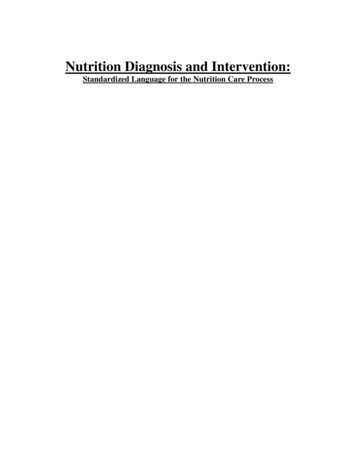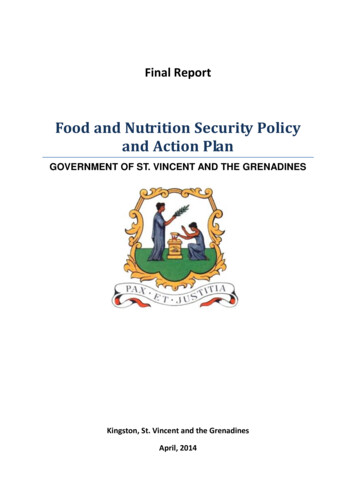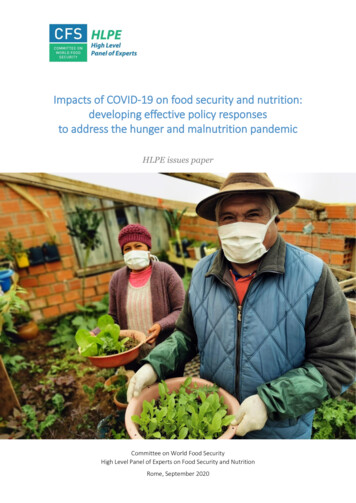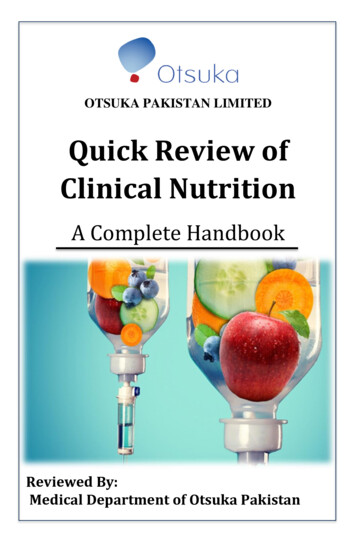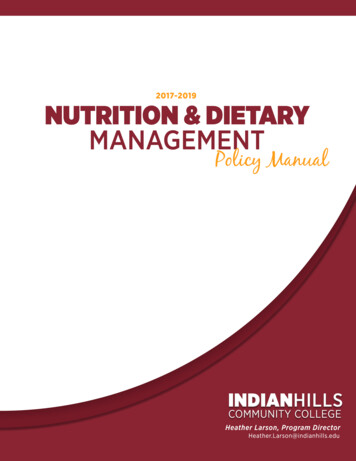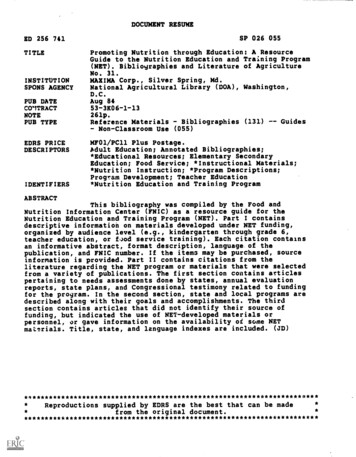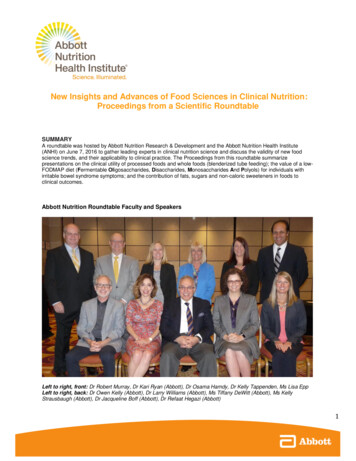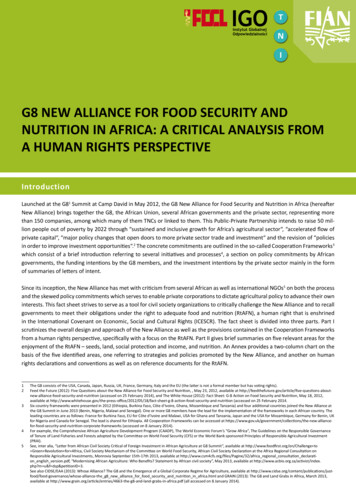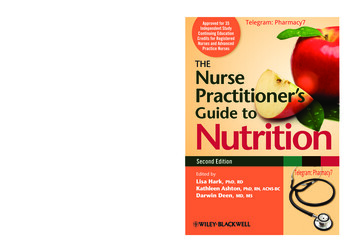
Transcription
JAMAICA – NATIONAL FOOD AND NUTRITION SECURITY POLICYFOOD AND NUTRITION SECURITY POLICYGOVERNMENT OF JAMAICAMinistry of Agriculture and FisheriesandMinistry of HealthMarch 20131
JAMAICA – NATIONAL FOOD AND NUTRITION SECURITY POLICYLIST OF ABBREVIATIONS AND erican Convention of Human RightsAcquired Immune Deficiency SyndromeAgricultural Land Use PolicyAgricultural Support Services ProjectFood and Nutrition SecurityConvention on the Elimination of All Forms of Discrimination AgainstWomenCaribbean Food and Nutrition InstituteConsumer Price IndexConvention of the Rights of the ChildCivil Society OrganizationsFood and Agriculture OrganizationFood and Drug AdministrationFood and Nutrition Security PolicyFood Safety Modernization Act of the Food and Drug AdministrationFood Technology Institute of the Scientific Research CouncilHazard Analysis Critical Control PointsHuman Immunodeficiency VirusInternational Covenant on Civil and Political RightsInternational Covenant on Economic, Social and Cultural RightsInter-American Development BankInformation System for Food and Nutrition SecurityInter-American Institute for Co-operation on AgricultureJamaica Promotions CorporationJamaica Manufacturers‟ AssociationJamaica Survey of Living ConditionsKingston Metropolitan AreaMonthly Clinic Summary ReportNon-Communicable DiseaseNational Export StrategyOffice of Disaster Preparedness and Emergency ManagementProgramme of Advancement through Health and EducationPlanning Institute of JamaicaQuality Management SystemsRecommended Dietary AllowancesScientific Research CouncilValue Added ProductsWorld Health Organization2
JAMAICA – NATIONAL FOOD AND NUTRITION SECURITY POLICYEXECUTIVE SUMMARYLow food production and high dependency on food imports combine to confront Jamaica withan unprecedentedly high and rising Food Import Bill (FIB) and a worrying food securityvulnerability to external economic shocks and climate change.Most of the food consumed in Jamaica is imported either raw or semi-processed for finalprocessing, while a small and declining portion comes from national/regional production. Atthe same time a large and rising proportion of the final cost of that food to consumers is takenup by services – manufacturing, packaging, distribution and marketing costs. Thus, the foodand financial crises of 2008 and 2009, and the resulting volatility of food prices that arecurrently above the previous highest level reached in mid 2008, have brought the nationalcommunity face to face with the harsh consequences of its high dependence on food imports.This situation also renders Jamaica more vulnerable to external economic shocks.So when there is drought in the northern hemisphere or floods in Australia and Pakistan, ashappened recently, the prices of wheat, corn and sugar jump to new highs on the world marketleading to similar increases in the national food import bill. And the cost of local chicken anddomestically produced livestock soars because Jamaica imports the raw materials (corn,coarse grains and soybeans) that are the basis of the animal feeds on which they are fed.At the same time, lack of access to food and its improper use have led to the emergence of the“double-burden” of malnutrition, which happens when both under and over-nutrition coexistin the same community. The diet of a majority of the population has shifted away from locallygrown produce, with limited foods of animal origin, to diets consisting of more processed andenergy-dense foods, more of animal origin, and more added salt, sugars and fats.Unfortunately, these new food consumption patterns have meant a shift in consumerpreferences towards nutritionally poor diets that have led to the increasing prevalence ofobesity, and nutritional related non-communicable chronic diseases (NCDs) such as diabetes,hypertension, stroke, heart diseases and some forms of cancers.These diseases, that are costly to individuals and to economies, are now one of the mainnational public health problems. They exist alongside persistent pockets of undernourishedpopulation that confront socio-economic inequalities limiting their capacity to obtain food(high levels of unemployment, poverty and income inequality and inequitable access toresources).Jamaica‟s food and nutrition security is also threatened by annual hurricanes, drought andfloods and the spectre of climate change. Due to climate change, these cyclical natural eventshave increased in intensity over the recent past thus making Jamaica more prone to temporaryfood insecurity. Given the diverse ways in which climate change can affect food security,agribusiness entrepreneurs, including farmers, as well as policy makers, should focus on anumber of key issues. Firstly, they should consider ways to reduce greenhouse gas emissions(mitigation measures) to lessen future effects of climate change. This can include activitiessuch as the use of sustainable (both traditional and cutting-edge) technologies to reduce thereliance on imported inputs, and increasing the use of renewable energy e.g. solar, wind,geothermal and biofuels in all sectors, but particularly in the agricultural sector. Secondly,there should be a focus on the development of early warning systems (together with crop andlivestock insurance schemes), which would be able to forecast periods of shortages,particularly for food production and the onset of extreme events. Thirdly, focus should be onfinding ways in which Jamaican farming systems can adapt to climate change, particularly inreducing farmers‟ vulnerability.3
JAMAICA – NATIONAL FOOD AND NUTRITION SECURITY POLICYSpecial attention has to be given to the adequate provision of water resources by increasinginvestment in water infrastructure and supply for the agricultural sector, providing a holisticwater management plan for water allocation in the wet and dry seasons. Funds should also beallocated for short and long-term rural research, marketing and consumer data studies (forboth residents and visitors), increasing and modernizing rural and urban markets andexpanding farmer training programmes. Incentives for increased water harvesting on farmsand in the residential sector, and for the provision of retention ponds and adequate drainage toreduce/avoid flood damage, should accompany incentives for other sustainable practices, suchas active engagement in biodiversity conservation.The National Food and Nutrition Security PolicyTo confront the above challenges to national food and nutrition security, this Policy and thesubsequent Action Plan will provide the strategies, actions and framework within which thesecritical issues of food and nutrition security will be addressed.The policy is the result of an inter-ministerial consultative process started in 2010 among allministries and state agencies which have a food security mandate so as to ensure that thenational response should (i) address the areas of production, consumption and storage; (ii)provide coherence and coordination to the work of the many Ministries and State Agenciesand the NGOs and private sector entities that work in these areas; (iii) not subvert the existingmarkets and the private sector; and (iv) ensure sustainability of the programmes and activitiesdesigned and effected.Food security plays a major role in the nutrition status of the population. Food security existswhen all people, at all times, have physical and economic access to sufficient, safe andnutritious food to meet their dietary needs and food preferences for an active and healthy life.Food security looks at food availability, food access, food consumption/utilization andstability of food supply. Therefore, the overall objectives of a food security policy are toensure that all people have continued access to sufficient supplies of safe foods for anutritionally adequate diet and in so doing achieve and maintain health and nutritionalwellbeing.Experiences in the region and elsewhere suggest that food production alone cannot guaranteefood security and nutrition. Therefore, food security itself is treated in the policy as the outputof a dynamic agricultural sector getting inputs from and providing inputs to the rest of theeconomy and to external markets. This is a departure from equating food security solely withfood production and availability and recognizes the reality that food security is an integral partof the policies, strategies and actions of several sectors of the economy.Philosophy and ObjectivesThe basic philosophy under-pinning food and nutrition security and the development of foodproduction and allied services in Jamaica is defined as the achievement of the optimum degreeof self-reliance through a strategy of feeding, clothing and housing the population, utilising tothe greatest extent possible and feasible, indigenous raw materials and human and naturalresources. In this context, the vision of the policy is that all Jamaicans at all times haveuniversal physical, social and economic access to sufficient, safe and nutritious food to meettheir dietary and food preferences for an active and healthy life. To this end, the long-termgoal of the policy is to achieve sustainable food and nutrition security and eliminate all formsof malnutrition, by ensuring the full protection and realization of the right to food for allJamaicans and residents of Jamaica, in order to have a well-nourished and healthy populationthat can fulfil its aspirations to good health and economic well-being and effectivelycontribute to national economic development.4
JAMAICA – NATIONAL FOOD AND NUTRITION SECURITY POLICYMore specifically, the policy will seek to: Ensure that a sufficient quantity of nutritious food of appropriate quality is available toall people in Jamaica, through increased domestic production and a sustainable level ofimports (Food Availability). Ensure that all individuals in Jamaica have access to adequate resources to acquireappropriate foods for a nutritious diet (Food Access). Ensure that all individuals in Jamaica reach a state of nutritional well-being throughfood choices and consumption that reflect Recommended Dietary Allowances (FoodUtilization). Ensure that all people in Jamaica have access to adequate, safe and nutritious food atall times, are not at risk of losing access to it due to shocks, and consume/utilize foods thatreflect physiological needs (Stability of Food Supply).The policy is delineated into four sub-sections, namely, food availability, stability of foodsupply, food access and food utilization. The main elements of each sub-section arehighlighted below.Food AvailabilityThe objective of this pillar is to promote the sustainable production of safe, affordable,nutritious, good quality Jamaican food commodities/products. Under this pillar, it is beingproposed that Government promote increased production of nutritious food at competitivemarket prices in a sustainable manner by creating an enabling environment to facilitateincreased food production. Under this approach, priority commodities will be selected on thebasis of the promotion of a nutritionally balanced diet comprised of local food products in linewith the food based dietary guidelines. The cost efficiency of value added production forlocally produced and imported semi-processed foods and livestock products and theimprovement of food safety systems are also paramount to the thrust of supporting the foodsector.One of the main underpinnings of this pillar is the enactment of a Food Security Law toensure the domestic production of a minimum threshold of a selected basket of foods forwhich there is production capability and national comparative advantage to meet domesticfood, nutrition and health goals.National comparative advantage means comparative advantage within different producingareas in Jamaica and not between Jamaica and other regional or extra-regional tradingpartners. Also, “threshold means that for a given food item in the selected basket of foods, aproportion must come from domestic production while the difference can come from imports.The threshold level for each major food item will depend on domestic production capability,whereby the greater the domestic capability, the higher will be the threshold and vice versa.The threshold will not be fixed in perpetuity, but will be subject to change from time to timedepending on development in technology which could improve domestic productioncapability. Likewise, the composition of the basket will not be fixed but will change from timeto time depending on domestic production capability, consumer tastes and preferences, andguided by the epidemiological profile of the population.This law will be supported by appropriate production and trade policies to increase productionand productivity of the domestic agriculture and agro-processing sectors and protect localindustries from unfair external competition. The policy proposes that under this legislation,the Minister responsible for the agricultural sector should be empowered to determine andadjust the specific output levels and types of crops and livestock products from time to time inline with changes in the national food production and agro processing capability andnational/regional trade policy. Imports of these products or close substitutes would be subject5
JAMAICA – NATIONAL FOOD AND NUTRITION SECURITY POLICYto approval by the agriculture ministry. To the extent feasible, it is also being proposed that atleast 75% of all food purchases made by Government directly or by public entities should befrom domestic/regional food production.In line with the National Food Security legislation, it is also being proposed that theGovernment will strongly promote the production of foods identified as critical to meeting thefood, nutrition and health goals and for which there is a national production capability. Thiswould be supported by an improved incentive framework, relevant trade policy support and apolicy framework and programme for selected commodities.Food StabilityThe objective of this pillar is to improve the food and nutrition security resilience of thenational community to natural and socio-economic shocks and climate change. It isrecognized that there are recurring threats to food security, and that their intensity isexacerbated by climate change, the effects of which can be mitigated, and for whichadaptation is essential to build resilience to this evolving threat. In this regard, the pillaremphasizes the implementation of adaptation and mitigation strategies as a means ofenhancing the stability of food security.To this end, therefore, policy recommendations include: Promote the creation of an Information System for Food and Nutrition Security(ISFNS) for food security development, as well as food crisis prevention and riskmanagement and the construction of adequate risk profiles for the main crops; Pursue climate resilient development which focuses on adaptation as well asmitigation strategies for the food and agriculture sector; Enhance the capacity of relevant institutions to provide climate related information incollaboration with relevant regional bodies; Integrate climate management considerations into the National Agricultural DisasterRisk Management Programme; Reduce the impact of climate change on food production; Utilization of vulnerability analysis and mapping to provide timely nutrition andsocio-economic information on vulnerable population groups to decision-makers to enable thedesign of more effective emergency and relief responses; Develop comprehensive agricultural insurance and risk transfer schemes; Subscription to a national and regional disaster fund.The pillar also places emphasis on disaster risk mitigation and response mechanisms byproposing a national network of emergency food stocks for a minimum of three months,emergency food plans for vulnerable groups and households and contingency plans forrecovery and rehabilitation in areas prone to natural disasters.Access to FoodThe objective of this pillar is to ensure access of households and individuals to sufficient,nutritious affordable food at all times. The pillar recognises the challenges facing individualsand families vulnerable to food insecurity. It proposes food security interventions that willensure the target food insecure population gains access to productive resources to improvetheir livelihood status. Where a segment of the target food insecure population is unable togain access to productive resources, then food security interventions will ensure that thissegment gains access to income and job opportunities to enhance its power to purchase food.Food security interventions proposed in this pillar are geared to ensuring that the targeted foodinsecure population is empowered to have nutritious and safe food. Where another segment ofthe target food insecure population is still unable to access sufficient food because of6
JAMAICA – NATIONAL FOOD AND NUTRITION SECURITY POLICYdisability, extreme conditions of destitution – food security interventions will ensure that thestate provides relief measures that may be short-to medium-term and/or on a sustained basis,depending on the nature of given interventions. It is proposed that interventions beunderpinned by analysis that is grounded on accurate information and that their impact beconstantly monitored and evaluated.Food Utilization/Consumption/Nutritional AdequacyThe objective of this pillar is to promote nutritionally adequate, safe, affordable dietaryintakes and other positive lifestyle behaviours throughout the life course. The pillar recognizesthe challenges facing the Jamaican population with respect to increasing levels of obesity,non-communicable chronic diseases, persistent iron deficiency anaemia and pockets of undernutrition. This pillar therefore aims to: Promote, protect and support appropriate infant and young child feeding practices; Promote consumption practices consistent with the national population dietary goals inline with international standards; Strengthen national nutrition surveillance systems in accordance with WHO standards,so as to monitor the nutritional status of the population and identify those at risk of nutritionrelated disorders; Develop and implement national guidelines on physical activity and dietary intake topromote health and wellness in schools, workplaces and communities; Provide nutrition standards and guidelines to strengthen programme development andimplementation in all sectors; and Implement policies and programmes to detect, prevent and manage all forms ofmalnutrition.State institutions and schools provide an entry point for interventions to prevent and controlsome of the identified nutrition conditions and influence food tastes and preferences and willbe targeted by this policy. Extensive public education and awareness campaigns will target thewider population to emphasize the benefits of eating healthy and nutritious local foods.The pillar also targets the strengthening and enactment of legislation to foster theimplementation/enforcement of food safety standards and food labelling, in keeping withinternational standards.A strong research agenda has been included in the development of the policy, and it cutsacross all four pillars with the aim of providing the necessary information to guide decisions.As such, Academia will be a critical stakeholder in the implementation process, specifically toprovide the expertise and guidance in the conduct of all relevant research to guide evidencebased decision making.Institutional FrameworkDue to the multidisciplinary nature of food security, it is proposed that an Inter-MinisterialCommittee on Food and Nutrition Security (IMCFNS), chaired in rotation by each of theconstituent ministries and having a permanent secretariat provided by the Ministry responsiblefor Agriculture, be established to ensure joint and concerted action in the formulation andimplementation of the programmes and measures under the Food and Nutrition SecurityPolicy. It is proposed that private sector and non-government organizations be integrated intothis Committee, with the possibility of the Chair also being drawn from the former grouping.It is proposed that the Committee report to Cabinet.The IMCFNS may establish a secretariat to carry out the functions and responsibilitiesassigned to it by the Cabinet and would draw its funding, in the first instance, from existing7
JAMAICA – NATIONAL FOOD AND NUTRITION SECURITY POLICYappropriations in the constituent Ministries; this procedure may be varied in future to providethe IMCFNS with assured funding, which may be of domestic and/or international origin.Under the IMCFNS, a Technical Working Group will also be set up with responsibility forproviding technical inputs as well as for the design, implementation arrangements, monitoringand evaluation of the IMCFNS‟s work programme.8
JAMAICA – NATIONAL FOOD AND NUTRITION SECURITY POLICYJAMAICA NATIONAL FOOD AND NUTRITION SECURITY POLICY1. INTRODUCTIONPREAMBLEFood security requires an available and reliable food supply at all times. At the global,regional and national levels, food supply can be affected by climate, disasters, war, civilunrest, population growth, lack of effective agricultural practices, and restrictions on trade.Government initiatives that encourage a policy environment based on macroeconomicstability and competitive markets can improve food availability. At the household level, foodsecurity is essentially a matter of access to food and its appropriate use to ensure the health ofindividual family members.Insecurity can be temporary or chronic. It may vary with age, status, gender, income,geographic location and ethnicity. Poverty is the main cause. Sustainable progress in povertyreduction is critical to improving access to food. Individuals need access to sufficient, safeand nutritious food. They need adequate health services, a healthy and secure environmentand a safe water supply. Food security is therefore closely linked to the economic and socialhealth of a nation, society and individual.Good nutrition is essential for healthy and active lives and has direct bearing on intellectualcapacity, which eventually impacts positively on national social and economic development.Underlying this principle is the practical application of appropriate diet and healthy lifestylesthat, albeit a matter of individual choice, are dependent on stable and sustainable foodsecurity, knowledge on which to base nutritional choices, quality caring practices, healthyenvironment, adequate supplies of safe drinking water and accessible quality health services.Therefore in order to maximise the health and economic benefits for the population, thereshould be in place sound food and nutrition policies and strategies.Given the onset of climate change the world over, current import trends that increase „foodmiles‟ (the length of the supply chain and hence transportation costs), and dependency onimported food must be redressed. Moreover, traditional exporters of key agriculturalcommodities may choose to cut exports if droughts, floods or other natural disasters threatentheir domestic markets. In 2007, droughts in Australia led to significant declines in dairyexports, which affected the availability of these products for the CARICOM consumer. In2010, droughts in Russia resulted in reduced wheat exports which led to increases in globalwheat prices. In 2012, drought in the northern hemisphere has once again reduced theavailability of corn and wheat in international markets. Rapid price increases in these andother staples such as sugar, have had significant impacts on the Caribbean‟s food import bill.Wages have not risen to match higher food costs; therefore the price of food has risen inrelation to that of other goods and services. Access to food, particularly for the mostvulnerable, has been threatened.Given the diverse ways in which climate change can affect food security, agribusinessentrepreneurs, including farmers, as well as policy makers, should focus on a number of keyissues. Firstly, they should consider ways to reduce greenhouse gas emissions (mitigationmeasures) to lessen future effects of climate change. This can include activities such as theuse of sustainable (both traditional and cutting-edge) technologies to reduce the reliance onimported inputs, and increasing the use of renewable energy e.g. solar, wind, geothermal andbiofuels in all sectors, but particularly in the agricultural sector. Secondly, there should be afocus on the development of early warning systems (together with crop and livestockinsurance schemes), which would be able to forecast periods of shortages, particularly forfood production and the onset of extreme events. Thirdly, focus should be on finding ways in9
JAMAICA – NATIONAL FOOD AND NUTRITION SECURITY POLICYwhich Jamaican farming systems can adapt to climate change, particularly in reducingfarmers‟ vulnerability.Special attention must be given to the adequate provision of water resources by increasinginvestment in water infrastructure and supply for the agricultural sector, providing a holisticwater management plan for water allocation in the wet and dry seasons. Funds should also beallocated for short and long-term rural research, marketing and consumer data studies (forboth residents and visitors), increasing and modernizing rural and urban markets andexpanding farmer training programmes. Incentives for increased water harvesting on farmsand in the residential sector, and for the provision of retention ponds and adequate drainage toreduce/avoid flood damage, should accompany incentives for other sustainable practices, suchas active engagement in biodiversity conservation.The emphasis on food, nutrition and health goals and the requirement for Jamaica‟sagriculture and food distribution system to meet these goals derive from three mainobservations. First, the country‟s main public health problems are food and nutrition-related,and this can be linked to lifestyle practices related to unhealthy diets, an observation which isreinforced by the types and quality of foods that are available (from domestic and importsources) to the Jamaican people. Second, despite a long history of food production and naturalresource endowments (farmers, land, climate and water) that are favourable for foodproduction, food imports into Jamaica have been increasing over the years (estimated atUS 810 million in 2010), while at the same time livestock and crop production (with theexception of a few crops in the past two years) has been declining over the past 50 years.Third, Jamaica (like its CARICOM partners) has depended on food imports since itsbeginnings as a plantation society; it is now imperative that the ecological and socio-economicpatterns of this history are adjusted to respond to new climatic and meteorological challenges.This Policy and the subsequent Action Plan will therefore provide the strategies, actionsand framework within which these critical issues of food and nutrition security will beaddressed.BACKGROUNDNutrition and Non-communicable Diseases1.1The Caribbean, including Jamaica, is undergoing a diet transition from atraditional diet with a limited range of staple foods towards a high-energy diet with moreanimal protein, saturated fats, sugars and highly processed foods1. This diet, often consumedaway from the home as street food, and at local fast food or “cook shops”, has resulted in apreponderance of over nutrition leading to obesity. Obesity is a major risk factor and a drivingforce in the prevalence of Non-communicable diseases (NCDs), such as diabetes,cardiovascular diseases and cancer.1.2Over the past decade, obesity levels have continued to spiral out of control withthe prevalence of NCDs reaching epidemic proportions as demonstrated by the following dataon NCDs and their risk factors in Jamaicans 15-74 years old2: 12Diabetes: prevalence of 7.2% in 2000, increased to 7.9% in 2008Pre-hypertension: prevalence of 29.9% in 2000 increased to 35.3% in 2008Hypertension: prevalence of 20% in 2000, increased to 25% in 2008Obesity: prevalence of 9.7% in 2000 increased to 25.3% in 2008Physical inactivity: 17% of the population in 2000, compared with 30% in 2008Labonté, R., Mohindra, K., Lencucha, R. Paths linking trade and chronic disease I: Diet in: Trade and Chronic Diseases: AnOverview. Institute of Population Health, University of Ottawa. Canada, 2010Wilks et al. Jamaica Health and Lifestyle Survey 2007/810
JAMAICA – NATIONAL FOOD AND NUTRITION SECURITY POLICYNCDs account for approximately 56% of deaths in Jamaica annually, causing illnesses,disabilities, premature death, productivity losses, increasing costs of care, poor quality of lifeand poverty. Persons in the lower socio-economic groups bear the brunt of the impact,particularly those with diabetes and hypertension1. It is estimated that at least 5% of Jamaica‟sGross Domestic Product (GDP) goes towards the treatment of diabetes and hypertensionthreatening our economic development 2.1.3Food security is being compromised mainly due to accessibility andconsumption/utilization in Jamaica. Food insecurity may lead to weight gain and obesity asthe less expensive foods tend to be high in calories and low in nutrients. In addition,households with limited resources tend to spend less on food overall and even less on healthyfoods, which tend to be more costly4. Ensuring access to low cost healthy food options isparamount to contributing to the achievement of food and nutrition security and better healthoutcomes.1.4It is noteworthy that women are disproportionately affected, as one in fourJamaican women is obese. In a study on Californian women, food insecurity was found to beassociated with increased likelihood of obe
Food security plays a major role in the nutrition status of the population. Food security exists when all people, at all times, have physical and economic access to sufficient, safe and nutritious food to meet their dietary needs and food preferences for an active and healthy life. Food security looks at food availability, food access, food .

